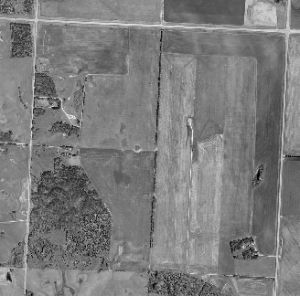| | Goals | Resources | Management plan | Implementation and monitoring
Woodlot management planning is necessary for successful woodlot operation. Planning helps you set priorities, potentially reducing costs for your woodlot venture.
Creating an effective plan requires technical knowledge and time. The planning process starts with identification of your goals, objectives, and the resources available and needed. The next step is to identify activities and strategies to achieve your personal and financial goals. Implementing and monitoring of all these activities are very important to manage your woodlots properly.
Five step woodlot management planning process:
IDENTIFY RESOURCES
(Inventory, money, labor, equipment, time, other) |
DEVELOP MANAGEMENT PLAN
(Woodlot management plan + business plan) |
IMPLEMENTATION AND MONITORING ACITVITIES |
PLAN ADAPTATION
(If conditions change) |
Goals
It is important to establish and know your goals. Assessing your priorities will help you establish short- and long-term goals. The goals and objectives should be clear, realistic and achievable. The goals might be various and some of them might be compatible, while others may conflict, but they have to be defined. Proper management practices will reduce or eliminate possible conflicts between goals. Goals should reflect your personal, economic and environmental needs.
It is very rare that landowner has only one goal for managing his woodlot. Some common landowner goals are:
- Wildlife habitat protection
- Recreation and eco-tourism
- Soil and water conservation
- Complement to agriculture crop
- Timber production
- Special forest production (berries, mushrooms, willows for wreaths, etc.)
- Source of income
- Security
- Forage production
- Aesthetics
Resources
After setting the goals and objective, assess the resources needed to achieve these goals and objectives. This assessment might include conducting a woodlot inventory, determining financial support, and identifying equipment, labor, and other needs.
Woodlot inventory
Conducting a woodlot inventory is a key step for your planning. The woodlot inventory will provide a wide range of information such as soil characteristics, vegetation information, wildlife information, topography, roads, water and other features. Below are necessary information that landowner has to obtain:
Maps: Forest management plan should include several maps. Start with a Section, Township, Range map, aerial photos (at a scale of 1: 20,000) and other important maps of your property (forest stand map, boundary map, topographic and soil map). You need to know the boundary of your property, the legal land description and any other legal agreements before beginning the inventory. You may need to have a land survey done to locate the legal boundary of your property.

Airphoto of Section of the land
Source by: Ag-Canada - Prairie Farm Rehabilitation Administration (PFRA)
Ecological information: Collect information on:
- soil types (e.g. Chernozemic, Luvisol, sandy, silty, clay, etc.);
- drainage and topography;
- slopes (steepness, stability, aspect);
- climate (e.g. average rainfall, prevailing wind direction and wind speed, average temperatures);
- ecoregion and subregion (e.g. Boreal, Parkland, Foothills),
- site conditions;
- wildlife information;
- watershed information (wetlands, stream, etc);
- history of the woodlot;
- man-made features and improvements;
- viewpoints and specific sites (historic and heritage sites) surrounding landscape features and concerns.
For more information go to:
Alberta Natural Region Land Classification System
Alberta Soil Information Center
Alberta Environment & Parks
Forest stand inventory data
The forest stand inventory data for the woodlot should provide information on: tree-species composition, age classes, density classes, forest type, understory vegetation, height, volume, stand health and vigor, estimate of total merchantable volume, and growth rate by tree species.
This information is essential for developing woodlot management plan. Based on this information, you can calculate an acceptable annual harvest, determine silviculture treatments, project financial costs and benefits and decide on other woodlot activities based on your goals and objectives.
Financial resources
Estimate your revenues and expenses for the woodlot operation. You may need to find financial support for such costs as labor, equipment, harvesting, reforestation and other activities.
Labor, equipment and time
Determine the available labor in your area, type of equipment necessary for your woodlot operation as well as the time needed to carry out the activities and monitoring.
All this resource information is critical and has to be evaluated before developing a sustainable woodlot management plan.
Management Plan
Management plan could be formal or informal depending of owners wishes and needs. The plan usually consists of a written section and maps. The written portion includes:
- Description of goals and objectives;
- Description of woodlot (woodlot inventory);
- Description of long and short term activities and actions to achieve goals and objectives;
- Records for income, expenses, harvest volumes, cost of reforestation and other information;
- Maps may include trails, streams, forest stand types, soils, water and other land features.
The management plan can be as short and simple as two or three pages or it can be longer and more complex. It may be developed to achieve a specific goal such as timber production, wildlife habitat, or eco-tourism, but in many cases an Integrated Resource Management plan is produced.
Developing the plan sometimes requires help from professional forester or woodlot specialist. The plan has to flexible and adaptable. Nothing should be "written in stone".
Implementation and Monitoring
Even the best management plan is worthless if it is not implemented. Monitoring is needed to determine whether the goals and objectives are being met. Monitoring activities include:
- noting the progress of implementing the management activities
- identifying necessary changes in the activities if goals and objectives are not being met,
- keeping a record of the activities.
|
|